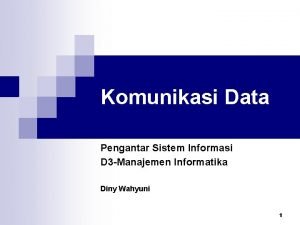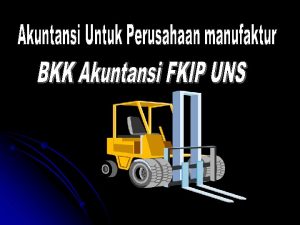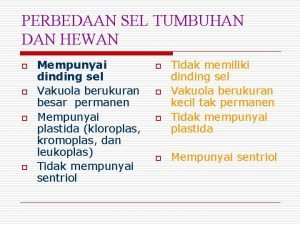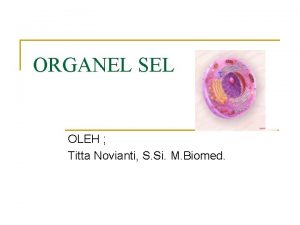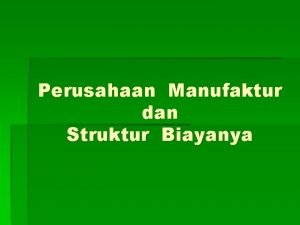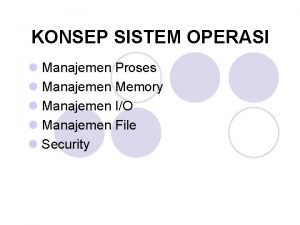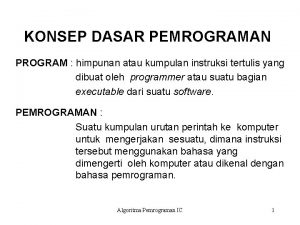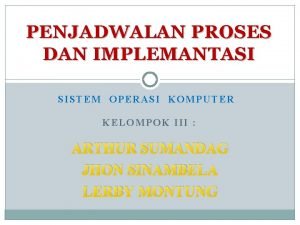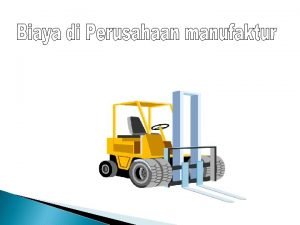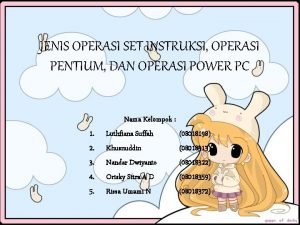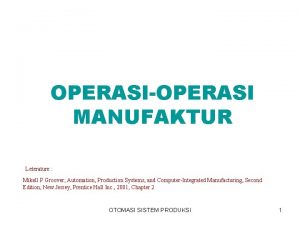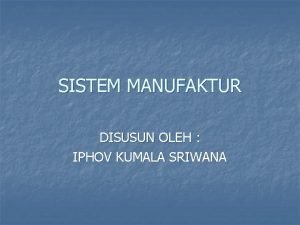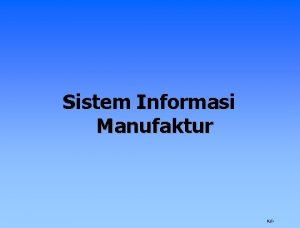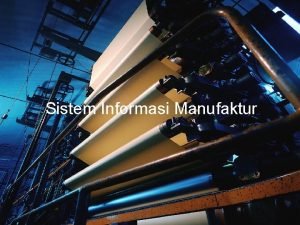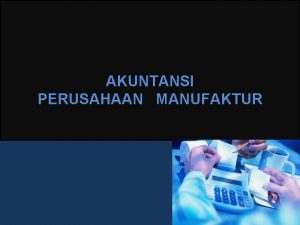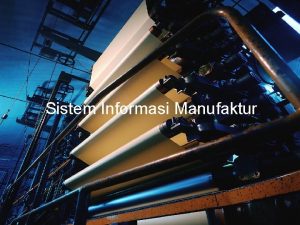SEL MANUFAKTUR Jenis Operasi pada FMS Operasioperasi pemrosesan















- Slides: 15

SEL MANUFAKTUR

Jenis Operasi pada FMS �Operasi-operasi pemrosesan (processing operations) �Operasi-operasi perakitan (assembly operations)

Penentu Tipologi Sebuah FMS �Each FMS is customized and unique �A typology for FMS depending on: (1) The number of machines it contains; (2) The level of flexibility, whether it is a dedicated or random-order FMS, in terms of the parts it processes.

Tipe FMS berdasarkan Jumlah Mesin 1. Single machine cell 2. Flexible manufacturing cell 3. Flexible manufacturing system (FMS)

1. Single machine cell �Contains one machine (often a CNC machining centre) connected to a parts storage system, which can load and unload parts to and from the storage system. �Designed to operate in batch mode, flexible mode, or a combination of the two. When in batch mode, the system processes parts of a single style in specific lot sizes before physical and programme changeover to the next batch specifications; in flexible mode the system satisfies three of the four tests for flexibility—the exception being error recovery, since, if the CNC machine centre breaks down, the system stops.

Single machine cell with one CNC machining centre and parts storage unit

2. Flexible manufacturing cell � Contains two or three processing workstations (often CNC machining or turning centres), plus a parts handling system. � This set-up can operate in flexible mode and batch mode, as necessary, and can readily adapt to evolving production schedule and increased production volumes. � Since there is more than one machine, error recovery is possible by re-routing the failed machine’s intended parts for processing to the other two machines in the system; and new part designs can be introduced with relative ease into the set-up. � The flexible manufacturing cell satisfies all four flexibility tests.

Flexible manufacturing cell with three identical processing stations, a load/unload station, and parts handling system

3. Flexible manufacturing system (FMS) � Consists of four or more processing stations � Connected mechanically by a common parts handling system and electronically by a distributed computer system. � FMS is larger than the flexible manufacturing cell, not only in the number of workstations it may contain, but also in the number of supporting stations in the system, such as part/pallet washing stations, co-ordinate measuring machines, storage stations and so on. � Computer control is also more sophisticated; it includes functions not found in the flexible manufacturing cell such as diagnostics and tool monitoring.

A seven-station flexible manufacturing system

Perbandingan Tiga Tipe FMS berdasarkan Jumlah Mesin

Tipe FMS berdasarkan Tingkat Fleksibilitas �Dedicated FMS �Random-order FMS

1. Dedicated FMS � Designed to produce a limited variety of part styles, and the complete universe of parts to be made on the system is known in advance. � Group technology is likely to be based on product commonality rather than geometric similarity. � Product design is relatively stable, so the system is designed with a certain amount of process specialization in place � Machines designed for specific processes can be implemented within the system, which leads to an increased production rate from the system. � In some cases, machine sequence may be virtually identical for all parts processed, so a transfer line may be appropriate as the system lay-out.

2. Random-order FMS � Designed to produce a large part family, where there are substantial variations in part configurations, and where it is likely that new part designs will be introduced into the system, with engineering changes occurring to existing parts. � The production schedule may also be flexible, changing from day to day. The random-order FMS must be more flexible than the dedicated FMS to accommodate these requirements. It is equipped with general purpose machines to deal with product variations, and is capable of processing parts in random order. � A more sophisticated computer control system is also required for this FMS type.

Perbandingan Dua Tipe FMS berdasarkan Tingkat Fleksibilitas
 Perbedaan sel hewan sel tumbuhan dan sel prokariotik
Perbedaan sel hewan sel tumbuhan dan sel prokariotik Fungsi sistem file
Fungsi sistem file Pendekatan dasar jaringan pada pemrosesan
Pendekatan dasar jaringan pada pemrosesan Sel manufaktur
Sel manufaktur Siklus kegiatan usaha manufaktur
Siklus kegiatan usaha manufaktur Fungsi sel haiwan
Fungsi sel haiwan Perbezaan sel haiwan dan sel tumbuhan
Perbezaan sel haiwan dan sel tumbuhan Mitochondrial dna
Mitochondrial dna Kehamilan spuria
Kehamilan spuria Sel yg tidak memiliki membran inti
Sel yg tidak memiliki membran inti Jenis perusahaan manufaktur
Jenis perusahaan manufaktur Operasi sel memori
Operasi sel memori Konsep sistem operasi manajemen operasi
Konsep sistem operasi manajemen operasi Pengertian konsep set adalah.
Pengertian konsep set adalah. Hasil belum terperoleh
Hasil belum terperoleh Konsep, penjadwalan, dan operasi di process sistem operasi
Konsep, penjadwalan, dan operasi di process sistem operasi


